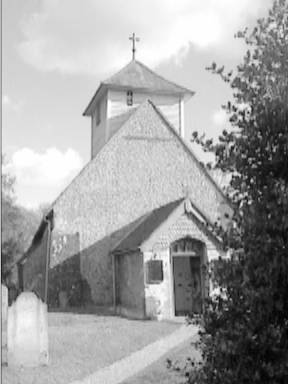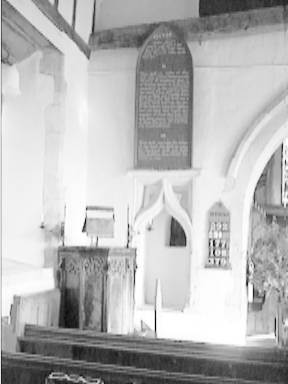![]()

![]()
36. All Saints, Dummer

This 12th century church south of Basingstoke and the M3 motorway, is full of charm and historical interest. Walk under the lychgate built as a memorial to the men of Dummer killed in the First World War and the squat wooden bell tower comes into view. It contains five bells, three of which date from the 1590's. Inside the West Door a large gallery built of huge timbers, overhangs much of the nave. A narrow staircase near the font leads up to the gallery and the adjoining belfry.
Boards inscribed with the Ten Commandments hang either side of the 13th century chancel arch and above is a massive medieval rood canopy, dark blue in colour with heraldic gold patterns, something rarely seen in churches today. On the south side of the arch a memorial to the Terry family covers a squint which can be clearly seen from inside the chancel.
On the north side of the arch is a very fine oak pulpit dating from 1380 making it one of the oldest in the county. From here a young curate George Whitfield preached in 1736. He later left the church and founded the Calvinistic Methodist Church. Near the pulpit in the North wall is a recess containing a tomb with a Purbeck marble slab. Near the lectern is a Latin memorial in rhyming form commemorating William Moore, alias Dummer, born in 1427.

Overhanging the nave from the gallery is the Sovereigns Standard of the Life Guards bear-ing battle honours including Dettingen (1747), Waterloo (1815), Ypres and the Somme. Under the gallery near the door is a board bearing the arms of Charles II, and another listing charitable gifts made to the parish such as that of John Milligate in 1610. He left a house and garden for the instruction of 6 boys of the parish. This marked the foundation of Dummer School which remained open until 1971. On the wall behind the font is a small but unusual hinged brass tablet. One side commemorates Allys Magewick (1591) and the other Robert Clerk a fifteenth century priest.
In the chancel the East Window is late Victorian by the artist Kempe, a memorial to Sir Nelson Ryecroft who died in 1894. Other windows on the south side show John the Baptist, a memorial to the Reverend John Lowell, rector from 1839-41, whilst a fine portrayal of St Michael is in memory of Charles Ryecroft who died in India in 1896. In the north wall two windows depict St Cecilia patron saint of musicians and the Good Shepherd.
The chancel is full of interesting memorial tablets. One on the south wall near the East Window commemorates the career of William Moore, alias Dummer (1508-93) in the City of London, where he served in the Town Clerk's office and later, in 1544, became controller of the Lord Mayor's Chamber. At his death he was Lord of the Manor of Dummer. On the north side of the chancel a poignant memorial describes the sad fate of John, eldest son of the Revd Michael Terry. On 10 August 1835, aged 19, 'while on duty on board the Roxburgh Castle off Calcutta, fell overboard and was drowned.' So perished this 'youth of unbending integrity, amiable manners and sober diligent and prudent habits... placed on his own resources at the age of 15.' Yet another son sacrificed for the cause of Empire.
Near the chancel arch a memorial of similar date commemorates Elizabeth, second daughter of Lt.General Forbes of Balbithan, Scotland, who died aged 25 in 1825 after bearing 'acute suffering attendant on a grievous consumption with Christian fortitude.' A much earlier memorial c.1600 relates to Richard Weston, Gent, 'born of ancient family in Kent', his wife Margaret and their 3 sons and 4 daughters.
The most recent memorial in the church dates from 1997 when the South window of the nave near the lectern was restored and new glass inserted. This depicts the coat of arms of the Grenadier Guards in honour of Lt.Col.Peter Clifton a former churchwarden and benefactor.
The churchyard, not surprisingly, is full of ancient tombstones, such as one relating to George Sharpe who died in 1838, having been Chief Huntsman to King George IV. All in all a church to linger in so full of history and atmosphere.
John Symonds
![]() Return to the March 2000 Features page
Return to the March 2000 Features page
![]() return to Home page and main index
return to Home page and main index
page last updated 3 MARCH 2000